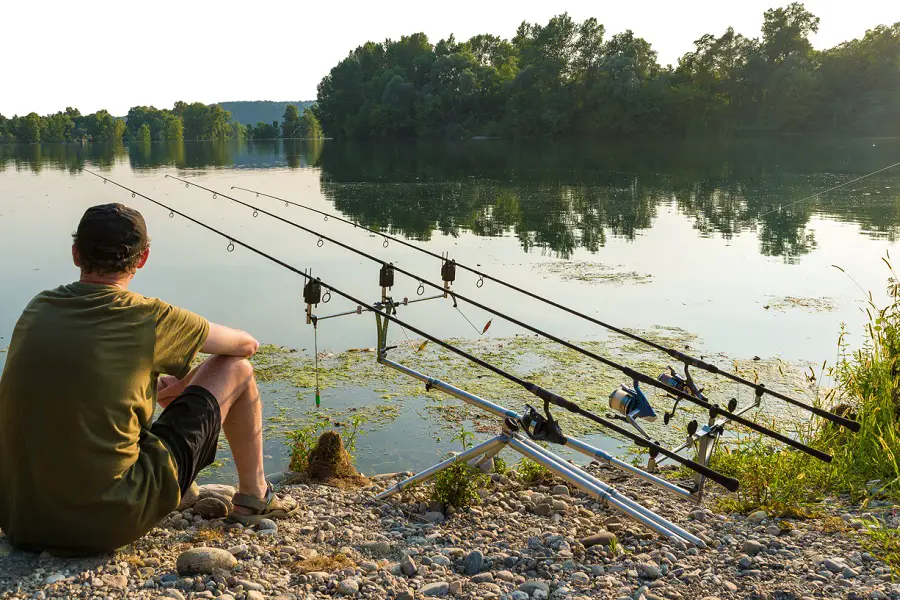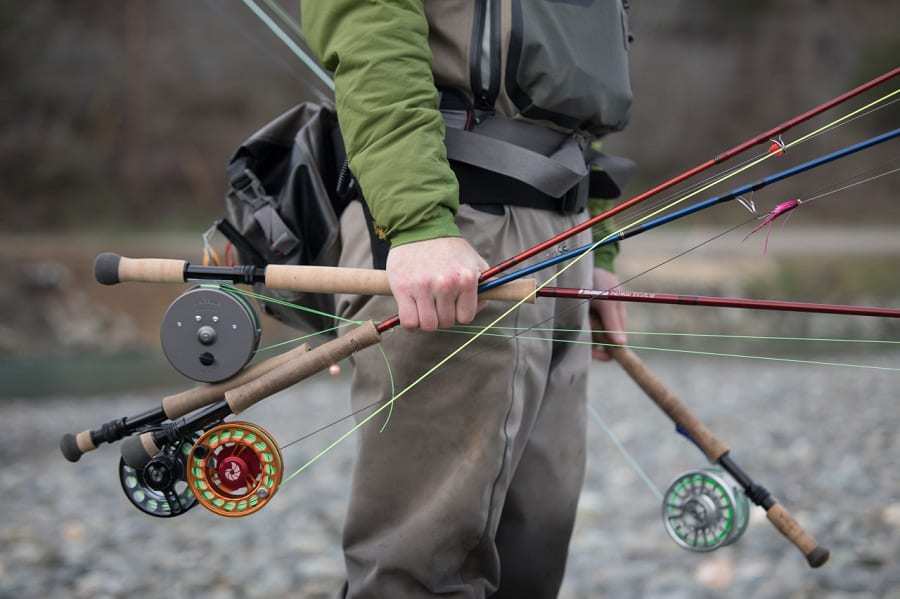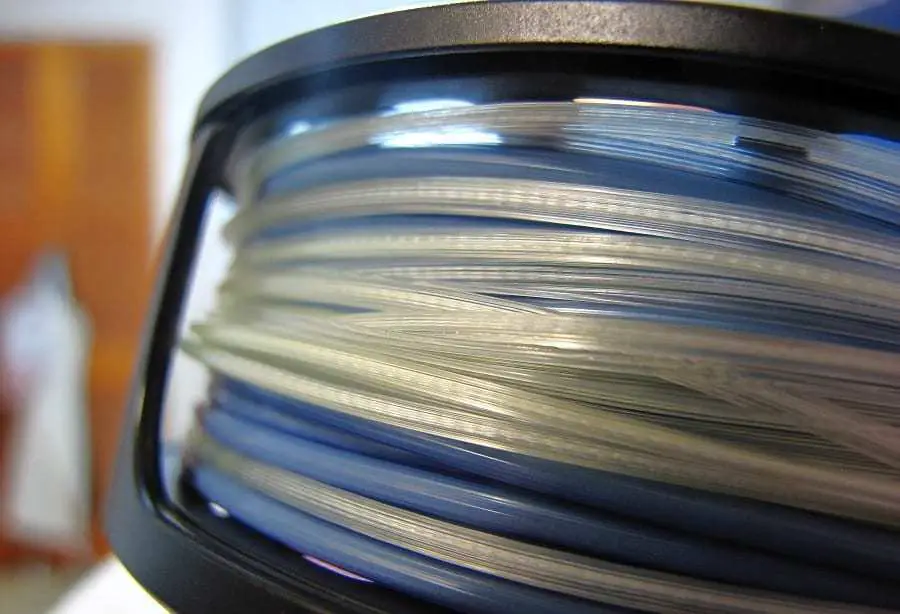If you’re planning on going fishing, but don’t have a lot of experience, lake and pond fishing can be a great place to start developing your fishing skills.
However, if you’re not sure where to start when it comes to setting up your fishing rig, then we’ve got you covered.
Below, we have some basic line setups for lake and pond fishing, and what conditions they’re best used in. We also have some general tips to help you out so we can help you get the best results.
Mixing and Matching
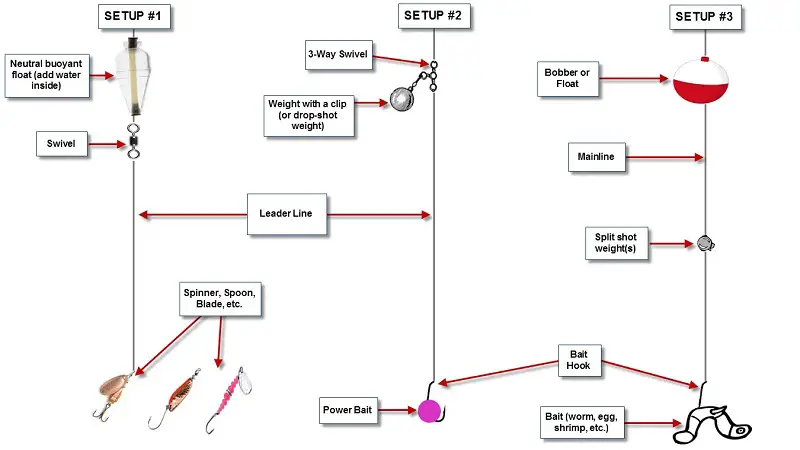
We’re going to start by looking at three basic setups for fishing at lakes and ponds. Before we begin, it’s worth noting that these three setups are all interchangeable, as all of them contain different combinations of elements across each of the setups.
For instance, you can replace the bobber from setup number 3 with the neutral buoyant float from setup number one.
Similarly, the split shot weight from setup number 3 can be replaced by the 3-way swivel and drop shot weight in setup number 2.
What we’re trying to say is that these three setups and how they’re explained below are not set in stone.
The point is to combine and play around with these different setups based on the type of fish you’re going after, and what gets you the results you’re after.
Setup Number 1 – Cast and Retrieving
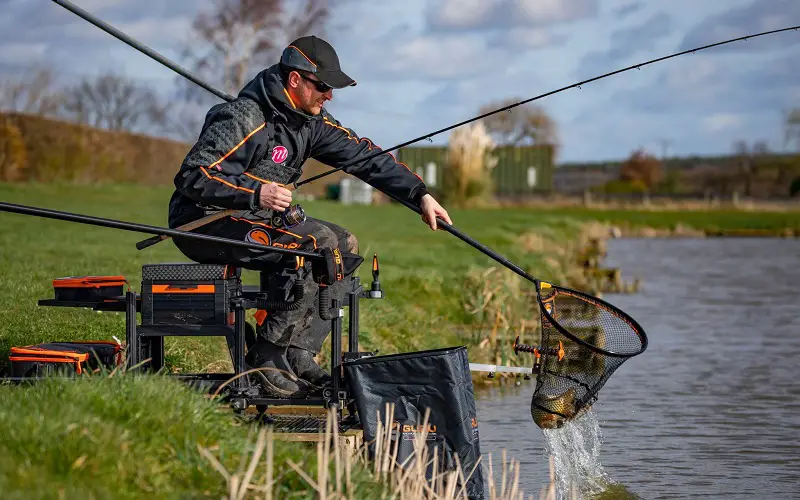
This first fishing setup is equipped so that an angler can continually cast and retrieve a metal or plastic lure. This setup is most effective for targeting fish towards the surface and middle area of the water.
The following parts you will need for this setup include:
Neutral Buoyant Float
There are many different variations of this float, but the reason why they’re called a “neutral buoyant” float is because they provide the option of adding water to the float. By adding water, you weigh down the float so that it can reach different depths depending on how much water you add.
Generally, it’s worth filling these floats about half full, as this will achieve fairly neutral buoyancy. The more water you add to the float, the quicker and deeper it will sink. This is one of the best things about using one of these floats as you can determine how far down you want your bait/lure to sit under the water.
Another great thing about neutral buoyant floats is that the float can act as a weight, allowing you to cast your line further out. This is a very important feature if you’re using a light tackle setup. Alternatively, you can choose to use weights instead, but these floats sink slower and are easier to cast.
Swivel
The next piece of equipment you’ll need is a swivel. A swivel is a small piece of metal that is used to connect the mainline to your leader line. They’re also used to remove line twists on your lines as they’ll twist or “swivel” around.
Swivels main purpose is to act as a connector between a braided mainline and a fluorocarbon/monofilament line leader. The swivel is particularly important if the braided line is highly visible, as you don’t want the fish to be able to see it.
The final purpose of a swivel is to act as a float stopper so that the float doesn’t slide all the way down to the bait or lure. They’re also pretty effective for acting as a bobber stop so that you can set the depth of your setup.
Spinner / Blade / Spoon
The final element of this setup will be the metal or plastic lure that you will use. For lake fishing, this will often mimic a minnow or bait fish. Depending on the species of fish you’re targeting, the lure will change. Spinners, blades or spoons are perfect lures for catching trout or pan fish.
Setup Number 2 – Fishing Off the Bottom
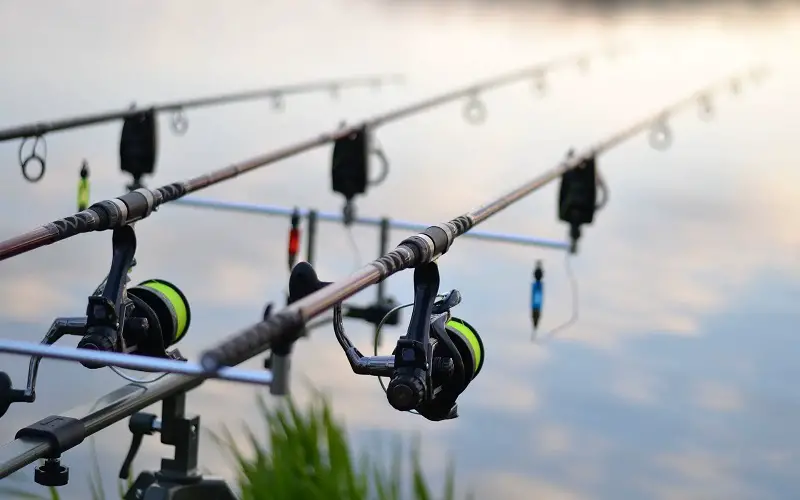
This second rig setup is designed for anglers who want to fish off the bottom of the water. So, this is for those of you who are targeting fish that are located near the bottom of the lakebed.
This is a great rig setup to use when the fish are not active near the water’s surface, as they’re likely travelling through the middle or deeper sections of the water. Fish activity is dependent on a variety of factors such as water temperatures and time of day. It will be most effective to use this setup during winter months, as this is when fish rarely come near the water’s surface as the temperatures are too cold.
For this setup, you will need:
3-Way Swivel
This is pretty similar to the swivel mentioned in the first setup as it connects the mainline to the leader line. However, a 3-way swivel has a third eye which allows you to attach an additional weight or line to the rig.
Some 3-way swivels have a snap instead of a third eye. These are good if you’re constantly changing your weights.
Weight
The type of weight you use for this setup doesn’t matter, as long as you can attach it to the 3-way swivel. The reason you’ll want to use a weight is so that the rig will sink to the bottom of the lake or pond, taking the bait with it.
Similarly, the size of the weight doesn’t matter either, but you’ll want to use something that has enough weight to cast well.
There are several factors that can affect the size of the weight you should use, including lure sizes and fishing line weight. So, try a few different weight sizes until you find one which has the perfect balance.
Leader Line
The leader line is the fishing line that runs from the swivel to the hook. For a leader line, we recommend using a fishing line strength that is less than the mainline. Typically, for this kind of setup, you would use a braided line for the main line, and either a fluorocarbon or mono line for the leader.
For a basic setup, it’s not necessary to use two different fishing lines, however, this is what will provide the best results. For lake fishing, the leader line doesn’t need to be too long, so anywhere between 12-18 inches will be fine.
Hook
You can use any type of hook, as long as it conforms to your local regulations. For this kind of setup we recommend using any type of single bait, worm, or even octopus-style hooks.
Bait
You can use any type of bait for bottom fishing. However, it’s important to think about what the bottom of the lake or pond consists of. For example, is it rocky? Muddy? Mossy?
For example, if a lakebed is covered in moss or foliage you should use a floating or neutral buoyant bait so that it won’t be hidden at the bottom of the lakebed.
This kind of rig setup is perfect if you’re fishing for trout.
Setup Number 3 – Suspended Bobber and Bait Fishing
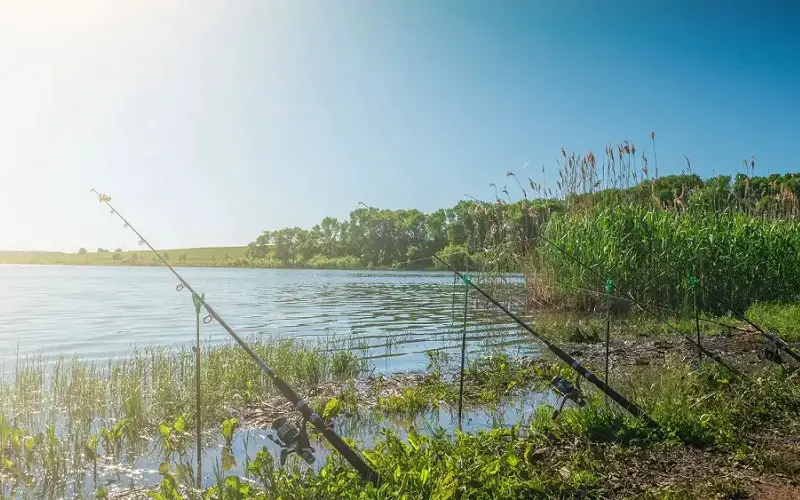
This is another great setup if you’re fishing near the water’s surface or in the middle section of the water. With this rig setup, you can choose at which depth you want to set your bait/lure, based on the length of the line between the bobber and the hook.
This is a classic starting setup for many anglers, as it’s easy to set up. This is a simple bobber, weight, worm rig.
Bobber / Float
Generally, bobbers and floats are made from plastic, foam, or cork. They are used to keep your bait suspended near the surface of the water.
You can also use a bobber as an indicator to know when you have a fish on the line as the float will bob from side to side. This is a very important visual indicator for beginner anglers.
Split Shots
These are small weights that are used to connect your fishing line. They’re typically made from lead and have a circular shape. Split shots also have a slight gap which allows you to “split” open the weight, and close the line inside it.
Split shots are very versatile weights that can be placed just about anywhere on your line. They can also be quickly replaced by bigger or smaller weights if needed.
Hook
Just like setup number 2, you can use whatever hook you like as long as it complies with local regulations.
Bait
For bait you can use worms, fish eggs, shrimp and so much more, but just remember – not all bait will do the same job. You need to factor in the species you’re targeting, the time of year, water temperature, and weather.
For this kind of setup, we recommend using some form of live or moving bait. This is because your lure will be stationary under the water, so bait that is moving around on the hook will attract nearby fish.
For trout, we recommend using worms as bait. If you’re targeting bass, use leeches and for walleye, use minnows. Whichever live bait you use, make sure it’s in line with local regulations.
Tips for Lake and Pond Fishing
If you’re new to angling, quick fishing trips can be a great place to start. It’ll take a lot of time and patience to become a great angler, so starting off with shorter, and more frequent fishing sessions will help you to quickly improve.
It’s also important that you practice your casting. If you’re fishing for bass, you will have to move fairly regularly and cast into various types of cover.
We hope this guide has helped you create some simple, basic rigs for lake and pond fishing. Don’t be afraid to mix and match setups until you find one that works best for you.
References:


